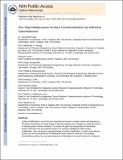One-Step Multipurpose Surface Functionalization by Adhesive Catecholamine
Author(s)
Kang, Sung Min; Hwang, Nathaniel S.; Yeom, Jihyeon; Park, Sung Young; Messersmith, Phillip B.; Choi, Insung S.; Lee, Haeshin; Anderson, Daniel Griffith; Langer, Robert S; ... Show more Show less
DownloadAnderson_One-step.pdf (1.250Mb)
OPEN_ACCESS_POLICY
Open Access Policy
Creative Commons Attribution-Noncommercial-Share Alike
Terms of use
Metadata
Show full item recordAbstract
Surface modification is one of the most important techniques in modern science and engineering. The facile introduction of a wide variety of desired properties onto virtually any material surface is an ultimate goal in surface chemistry. To achieve this goal, the incorporation of structurally diverse molecules onto any material surface is an essential capability for ideal surface modification. Here, a general strategy for surface modification is presented in which many diverse surfaces can be functionalized by immobilizing a wide variety of molecules. This strategy functionalizes surfaces by a one-step immersion of substrates in a one-pot mixture of a molecule and a catecholamine surface modification agent. This one-step procedure for surface modification represents a standard protocol to control interfacial properties.
Date issued
2012-04Department
Massachusetts Institute of Technology. Department of Chemical Engineering; Koch Institute for Integrative Cancer Research at MITJournal
Advanced Functional Materials
Publisher
Wiley Blackwell
Citation
Kang, Sung Min, Nathaniel S. Hwang, Jihyeon Yeom, Sung Young Park, Phillip B. Messersmith, Insung S. Choi, Robert Langer, Daniel G. Anderson, and Haeshin Lee. “One-Step Multipurpose Surface Functionalization by Adhesive Catecholamine.” Adv. Funct. Mater. 22, no. 14 (April 17, 2012): 2949–2955.
Version: Author's final manuscript
ISSN
1616301X
1616-3028